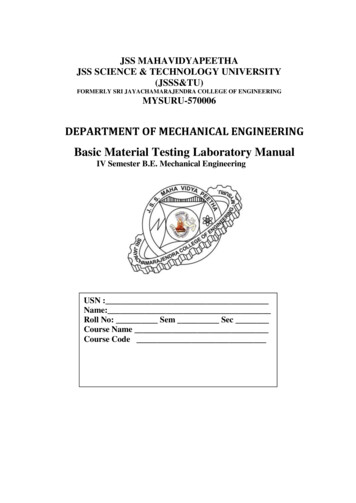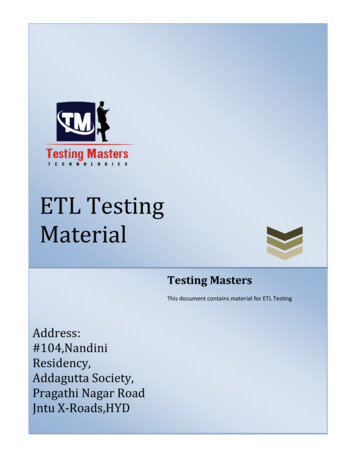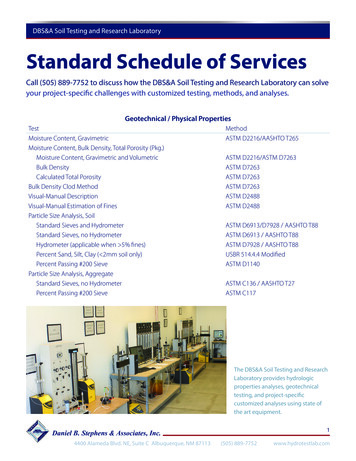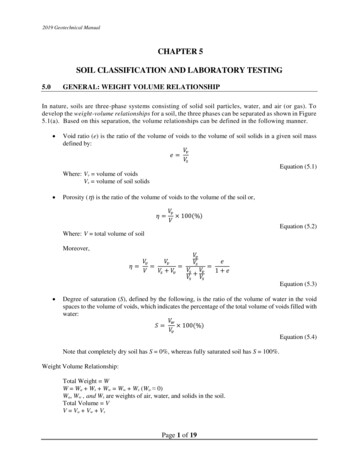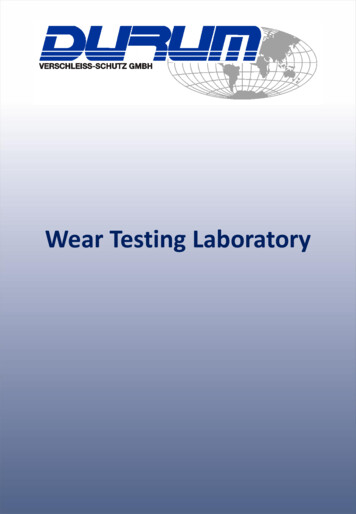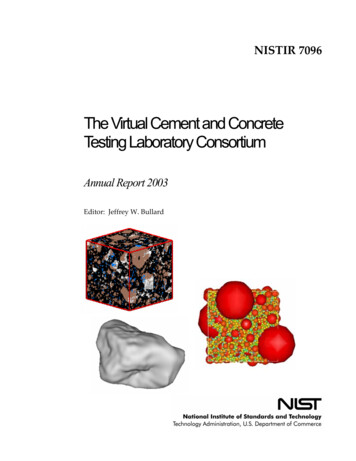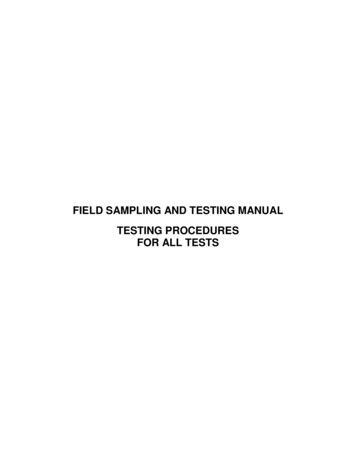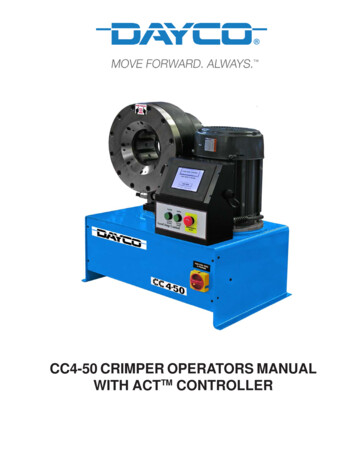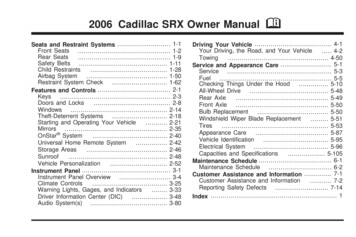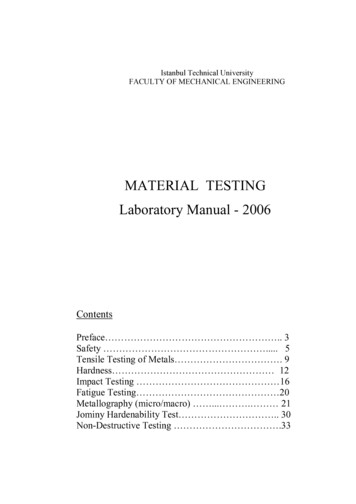
Transcription
Istanbul Technical UniversityFACULTY OF MECHANICAL ENGINEERINGMATERIAL TESTINGLaboratory Manual - 2006ContentsPreface . 3Safety . 5Tensile Testing of Metals . 9Hardness 12Impact Testing 16Fatigue Testing 20Metallography (micro/macro) . . 21Jominy Hardenability Test . 30Non-Destructive Testing .33
MATERIALS LABORATORY 2006Materials Laboratory AttendanceThis attendance sheet will be signed by the test assistant after each test. If youhave not studied the necessary material before coming to the laboratory or if youdon't show the necessary interest during the test, the assistant will not approveyour attendance and you will have to REPEAT THE ARPY / FATIGUEMACROSCOPY /MICROSCOPYJOMINYNON-DESTRUCTIVE2APPROVAL
MATERIALS LABORATORY 2006PREFACEA. IntroductionIn this course we are seeking to understand material properties throughlaboratory experiments. Usually the class is divided into groups. Each group willdo a different experiment every week until all the required experiments arecompleted.Each instructor will indicate the experiments to be conducted and adviseon the nature of the lab report and time of submission. However, a typical formatfor a lab report is included below. It is important that all the information necessaryto complete the lab report is obtained before students leave the lab.B. Lab Report RequirementsGENERALThe following suggestions should be helpful. Avoid personal pronouns. If you quote from a text, identify the text. View this report as though you were in industry and writing foryour boss. Hence sloppiness will not be accepted.FORMAT1. TITLEThere should be a Title Page with title, authors, group number, date, forwhom report was written.II. ABSTRACTIt should be approximately half a typed page in length. An abstract shouldtell: What was done briefly how experiment was conducted to satisfyobjectives and what the major conclusions or representative results are.III. TABLE OF CONTENTSMust have page numbers of different sections in the report.IV. INTRODUCTIONA. Establish general interest in the subject.B. Establish specific interest and justification for conducting thisinvestigation leading to a statement of the specific objective(s).C. Introduce the report itself. That is, tell the reader how the report isorganized and what to expect.V. THEORYA. Present theoretical basis for the experiment or investigation.B. Present equations used with clear indication of which variables weremeasured and which is calculated.VI. EXPERIMENTAL APPARATUSA. Diagram of the test set-up illustrating the general relationships amongthe various components of the system and the locations at which themeasurements were taken.B. Instrumentation (measurement systems) that was used should be statedand related to the measurement locations on the diagram (with a statement of the uncertainty associated with each measurement system).3
MATERIALS LABORATORY 2006VII. TEST PROCEDUREVIII. DATA ANALYSISIX. RESULTSIntroduce results; that is, explain what is being presented. Don't justinclude the plots, charts, etc., without any explanation.Tables and figures must be self-contained. They must be numbered andwith a caption. Thus the reader can tell what a table or figure meanswithout having to look through the text.X. DISCUSSION OF RESULTSA. Interpret and explain resultsB. Point out most important resultsEven if the results as presented seem obvious to you, you want to besure your reader notices the most important features and trends, etc.State what you think the results show, prove, demonstrate or illustrate.XI.CONCLUSIONSummarize your findings; that is, itemize the most important things thatyou found out, measured, observed. Anything that could be preceded by"It was found that" or "It was discovered that" is a finding, not aconclusion. Remember conclusions are generalizations based on results ofa specific investigation.XII. BIBLIOGRAPHYNumber your references in order.XIII. APPENDICESExtensive pages of data can go in Appendix.C. Safety1. Follow all safety instructions given in the class and in the laboratories.2. Charpy machine can be lethal. Never leave the hammer in the up positionuntil ready to break a specimen.3. Furnaces. Be careful in touching and handling specimens. Use tongs forplacing specimens in the furnace and removing them. Most specimens canbe quenched in water after removal from furnace.4. Tensile Testing. During the tensile test pieces can fly out during fracture.5. Use safety eye shield when grinding specimens.6. Do not remove specimens from abrasive cut-off machine until the wheel hasstopped.7. NO eating or drinking in the lab.4
MATERIALS LABORATORY 2006SAFETY IN THE LABORATORYAll students must read and understand the information in this document withregard to laboratory safety and emergency procedures prior to the first laboratorysession. Your personal laboratory safety depends mostly on YOU. Effort hasbeen made to address situations that may pose a hazard in the lab but theinformation and instructions provided cannot be considered all-inclusive.Students must adhere to written and verbal safety instructions throughout theacademic term. Since additional instructions may be given at the beginning oflaboratory sessions, it is important that all students arrive at each session on time.With good judgment, the chance of an accident in this course is very small.Nevertheless, research and teaching workplaces (labs, shops, etc.) are full ofpotential hazards that can cause serious injury and or damage to the equipment.Working alone and unsupervised in laboratories is forbidden if you are workingwith hazardous substances or equipment. With prior approval, at least two peopleshould be present so that one can shut down equipment and call for help in theevent of an emergency.Safety training and/or information should be provided by a faculty member,teaching assistant, lab safety contact, or staff member at the beginning of a newassignment or when a new hazard is introduced into the workplace.Emergency Response1. It is your responsibility to read safety and fire alarm posters and follow theinstructions during an emergency2. Know the location of the fire extinguisher, eye wash, and safety shower inyour lab and know how to use them.3. Notify your instructor immediately after any injury, fire or explosion, orspill.4. Know the building evacuation procedures.Common SenseGood common sense is needed for safety in a laboratory. It is expected that eachstudent will work in a responsible manner and exercise good judgment andcommon sense. If at any time you are not sure how to handle a particularsituation, ask your Teaching Assistant or Instructor for advice. DO NOTTOUCH ANYTHING WITH WHICH YOU ARE NOT COMPLETELYFAMILIAR!!! It is always better to ask questions than to risk harm to yourself ordamage to the equipment.Personal and General laboratory safety1. Never eat, drink, or smoke while working in the laboratory.2. Read labels carefully.5
MATERIALS LABORATORY 20063. Do not use any equipment unless you are trained and approved as a userby your supervisor.4. Wear safety glasses or face shields when working with hazardousmaterials and/or equipment.5. Wear gloves when using any hazardous or toxic agent.6. Clothing: When handling dangerous substances, wear gloves, laboratorycoats, and safety shield or glasses. Shorts and sandals should not be wornin the lab at any time. Shoes are required when working in the machineshops.7. If you have long hair or loose clothes, make sure it is tied back orconfined.8. Keep the work area clear of all materials except those needed for yourwork. Coats should be hung in the hall or placed in a locker. Extra books,purses, etc. should be kept away from equipment, that requires air flow orventilation to prevent overheating.9. Disposal - Students are responsible for the proper disposal of used materialif any in appropriate containers.10. Equipment Failure - If a piece of equipment fails while being used, reportit immediately to your lab assistant or tutor. Never try to fix the problemyourself because you could harm yourself and others.11. If leaving a lab unattended, turn off all ignition sources and lock the doors.12. Never pipette anything by mouth.13. Clean up your work area before leaving.14. Wash hands before leaving the lab and before eating.Electrical safety1. Obtain permission before operating any high voltage equipment.2. Maintain an unobstructed access to all electrical panels.3. Wiring or other electrical modifications must be referred to the ElectronicsShop or the Building Coordinator.4. Avoid using extension cords whenever possible. If you must use one,obtain a heavy- duty one that is electrically grounded, with its own fuse,and install it safely. Extension cords should not go under doors, acrossaisles, be hung from the ceiling, or plugged into other extension cords.5. Never, ever modify, attach or otherwise change any high voltageequipment.6. Always make sure all capacitors are discharged (using a grounded cablewith an insulating handle) before touching high voltage leads or the"inside" of any equipment even after it has been turned off. Capacitors canhold charge for many hours after the equipment has been turned off.7. When you are adjusting any high voltage equipment or a laser which ispowered with a high voltage supply, USE ONLY ONE HAND. Your otherhand is best placed in a pocket or behind your back. This procedureeliminates the possibility of an accident where high voltage current flowsup one arm, through your chest, and down the other arm.6
MATERIALS LABORATORY 2006Mechanical safety1. When using compressed air, use only approved nozzles and never directthe air towards any person.2. Guards on machinery must be in place during operation.3. Exercise care when working with or near hydraulically- or pneumaticallydriven equipment. Sudden or unexpected motion can inflict serious injury.Chemical safety1. Treat every chemical as if it were hazardous.2. Make sure all chemicals are clearly and currently labeled with thesubstance name, concentration, date, and name of the individualresponsible.3. Never return chemicals to reagent bottles. (Try for the correct amount andshare any excess.)4. Comply with fire regulations concerning storage quantities, types ofapproved containers and cabinets, proper labeling, etc. If uncertain aboutregulations, contact the building coordinator.5. Use volatile and flammable compounds only in a fume hood. Proceduresthat produce aerosols should be performed in a hood to prevent inhalationof hazardous material.6. Never allow a solvent to come in contact with your skin. Always usegloves.7. Never "smell" a solvent!! Read the label on the solvent bottle to identifyits contents.8. Dispose of waste and broken glassware in proper containers.9. Clean up spills immediately.10. Do not store food in laboratories.Lasers safety1. NEVER, EVER LOOK INTO ANY LASER BEAM, no matter how lowpower or "eye safe" you may think it is.2. Always wear safety goggles if instructed by your Instructor or TeachingAssistant.3. The most common injury using lasers is an eye injury resulting fromscattered laser light reflected off of mountings, sides of mirrors or from the"shiny" surface of an optical table. The best way to avoid these injuries isto always wear your goggles and NEVER LOWER YOUR HEAD TOTHE LEVEL OF THE LASER BEAM! The laser beam should always beat or below chest level.4. Always use "beam stops" to intercept laser beams. Never allow them topropagate into the laboratory. Never walk through a laser beam. Somelaser beams of only a few watts can burn a hole through a shirt in only afew seconds.5. If you suspect that you have suffered an eye injury, notify your instructoror teaching assistant IMMEDIATELY! Your ability to recover from aneye injury decreases the longer you wait for treatment.7
MATERIALS LABORATORY 2006Additional Safety Guidelines Never do unauthorized experiments.Never work alone in laboratory.Keep your lab space clean and organized.Do not leave an on-going experiment unattended.Always inform your instructor if you break a thermometer. Do not cleanmercury yourself!!Never taste anything. Never pipette by mouth; use a bulb.Never use open flames in laboratory unless instructed by TA.Check your glassware for cracks and chips each time you use it. Crackscould cause the glassware to fail during use and cause serious injury toyou or lab mates.Maintain unobstructed access to all exits, fire extinguishers, electricalpanels, emergency showers, and eye washes.Do not use corridors for storage or work areas.Do not store heavy items above table height. Any overhead storage ofsupplies on top of cabinets should be limited to lightweight items only.Also, remember that a 36" diameter area around all fire sprinkler headsmust be kept clear at all times.Areas containing lasers, biohazards, radioisotopes, and carcinogens shouldbe posted accordingly. However, do not post areas unnecessarily and besure that the labels are removed when the hazards are no longer present.Be careful when lifting heavy objects. Only shop staff may operateforklifts or cranes.Clean your lab bench and equipment, and lock the door before you leavethe laboratory.8
MATERIALS LABORATORY 2006TENSILE TESTING OF METALSObjectiveThe tensile test measures the resistance of a material to a static or slowlyapplied force. This laboratory experiment is designed to demonstrate theprocedure used for obtaining mechanical properties as modulus of elasticity, yieldstrength, ultimate tensile strength (UTS), toughness, uniform elongation,elongation and reduction in area at rupture. Besides the true stress- true straincurve can also be determined with the help of the tensile test.IntroductionIn this test the load is applied along only one axis, and the rate of loading isc
on the nature of the lab report and time of submission. However, a typical format for a lab report is included below. It is important that all the information necessary to complete the lab report is obtained before students leave the lab. B. Lab Report Requirements GENERAL The following suggestions should be helpful. Avoid personal pronouns. If you quote from a text, identify the text. View .File Size: 450KBPage Count: 40
